This Update covers July 1st - July 31st 2007 It is in three parts:
Despite the growing domestic awareness of global environmental concerns (such as global warming), and the obvious costs to the domestic natural resource base, South Korea’s building spree looks set to continue. According to published news reports, in mid-July the ground was broken for a massive new administrative city in South Chuncheong Province, at an estimated financial cost of 54 trillion won (or 58 billion US dollars equivalent); at the end of the month the Ministry of Finance and Economy then released initial plans to increase domestic tourism through more golf-course construction on “less productive” farmland (the nation’s 251 golf-courses proving insufficient to meet demand apparently), with this to be followed by a national marina development plan to be released in the second half of 2008; and one of the main election pledges of a leading political figure, a former CEO of one of Korea’s largest construction companies, remains the proposed construction of a massive canal system, linking the Han and Nakdong Rivers. All of this proposed construction in one of the already most developed nations on Earth.
Very much smaller in scale, but more positive for Korean conservationists, has been the launch in July of the independent Restore Saemangeum website, run by an Australian activist, Ms. Ricki Coughlan. This innovative website aims to generate 40 000 emails of concern for Saemangeum (one email for every hectare of natural wetland being destroyed by the Saemangeum reclamation), directed at this time to South Korean embassies and consulates around the world, as well as to the Ramsar focal point in the Ministry of Environment. The Restore Saemangeum website has apparently already generated well over 1100 emails in only three weeks, and is now looking for people who would like to translate website pages and help coordinate Saemangeum and Geum Estuary email campaigns in their own countries – a role that Birds Korea international members seem very well-placed to take.
To help the campaign to restore Saemangeum and to have the Geum Estuary protected by national law and designated a Ramsar site, please visit the Restore Saemangeum website, and please pass on the website URL (http://www.restoresaemangeum.com) to others. Continuing expression of domestic and international concern over this reclamation between now and next year’s Ramsar Convention conference (to be held in Changwon City, South Korea, in late October 2008) will be extremely effective in helping to promote long-term wetland conservation in Korea and the Yellow Sea as a whole: vital to maintain the sea’s biodiversity and productivity.
Clearly, as a world leader in many fields, South Korea now needs to take a stronger, leading role in conservation of the Yellow Sea, to help protect its own as well as the region’s shared natural resource base. Not only Yellow Sea fisheries are shared and threatened of course. Research from the SSMP and elsewhere also suggests that some of the shorebirds that stage in South Korea then move up to tidal-flats in the northern part of the Yellow Sea for further refueling, before migrating on towards their breeding grounds. Many of these wetlands are also threatened with reclamation. Especially disturbing is the ongoing Caofeidian industrial construction project in the northern (Chinese) part of the Yellow Sea, a result of the relocation of some of the most polluting industries out of Beijing as part of preparations for the next “environmentally-friendly” Olympics. For the developer’s spin on this devastating development that will destroy 15,000 ha of tidal-flats and shallows (not so distant from Happy Island, one of the word’s best-known migrant hotspots), please go to e.g. Chinadaily's article or Google- search “Caofeidian”.
July has been another busy month for Birds Korea. Beyond extensive behind-the-scenes overhauls of website coding and process on both of our websites (many thanks especially to Mr. Andreas Kim, Ms. Lydia Slobodian, our National Coordinator Ms. Park Meena and Ms. Kim Hyang-Ran), we have been joined by three new volunteers (Ms. Lee Meehee, Ms. Park Hyunsook and Ms. Choi Minyoung) who are helping us with office-based work. We also held several meetings with members and activists in Busan, and received good coverage of some aspects of our work by a leading local newspaper, the Busan Ilbo (see: Korean Birds Korea website. The month also included: a presentation on conservation by our director, Mr. Nial Moores, to approximately 30 university-aged students from South Korea and several other Asian nations at Ganghwa Island, at a meeting organized by the Seoul Youth Center for Cultural Exchange (http://www.mizy.net/) (July 3rd); presentations by Mr. Moores and Mr. Rakhyun Kim at the Australasian Wader Studies Group (AWSG) Conference on “Migratory Shorebirds in a Threatened Flyway” at Newcastle University, Australia (July 6th-8th) (for more information visit www.birdskorea.or.kr);
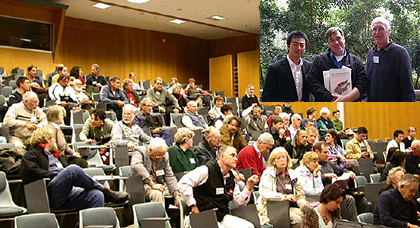
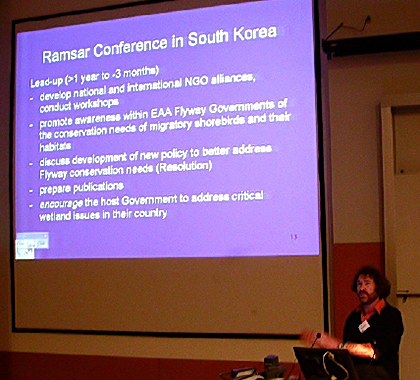
A small meeting for members and SSMP volunteers in Iksan (on July 20th); and an English/Environment Camp held at Changwon University and the Joonam Eco-centre (Changwon), organized by the Nakdong River Office/UNDP-GEF Wetlands project of the Ministry of Environment, funded by Changwon City (the host city for the 2008 Ramsar Convention conference), and led by Birds Korea, over the weekend of July 28th and 29th.
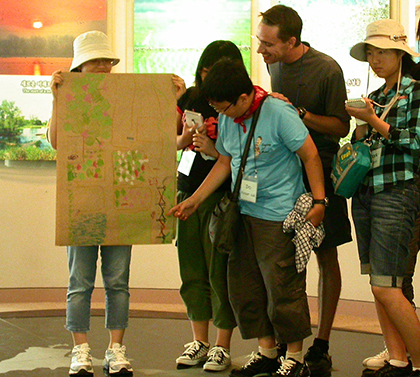
The Joonam Camp was conducted in extreme heat (with temperatures reaching 35 C), but thanks to the great work of the organizers and the many volunteers (including 7 foreign nationals, who traveled from Iksan, Wonju and Mokpo to involve), it was a great success. We aim to post more about this Camp, including images, in the coming weeks.
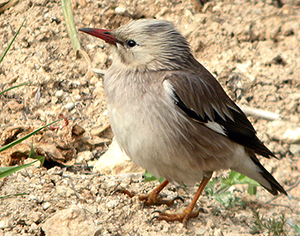
(Birds Korea library image: April 2005).
Very few reports of note were received during the month. The most obvious highlights included an over-summering Oriental Stork Ciconia boyciana on Jeju and even more significant a brood of Red-billed Starling Sturnus sericeus photographed at the nest in Jeju City, also on July 5th and also by Kang Hee-man (look here for more) – this apparently South Korea’s first proven breeding record.
The Red-billed Starling is one of this year's new additions to the Korean list of breeding species. To date, almost 190 bird species have now been recorded breeding on the Korean peninsula.
In addition, a pair of Pheasant-tailed Jacana Hydrophasianus chirurgus were found breeding at Upo Ramsar site (news via Hong Su-Yeon), the first mainland breeding record of this species, and there were also apparently two Pheasant-tailed Jacana reported at Joonam reservoir mid-month (Joonam REC summer review, July 2007), with one full adult male still present there during the Joonam English Camp on July 28th (Emily Styles, Andreas Kim and others).
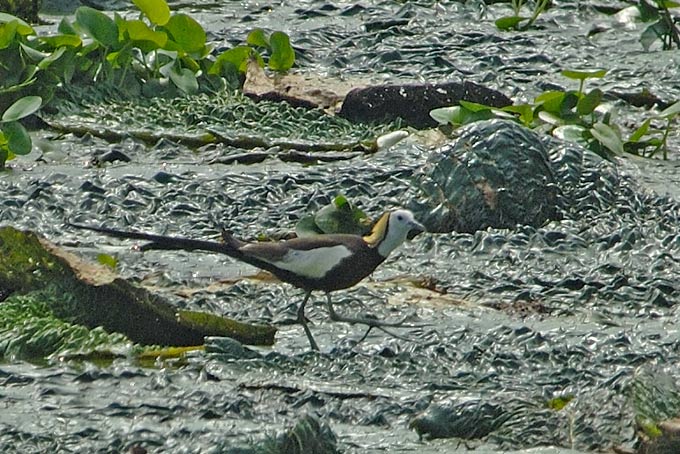
Finally,a gentle reminder to all of our members, past and present, living in Korea. Birds Korea depends entirely on the support of our members and volunteers. Donations and domestic membership fees are vital to us! Please renew your membership (annual membership fee is only 30000 Korean won; and life-time membership only 150 000 Korean won at this time), and help us to help the birds!
Birds Korea, July 31st 2007.




